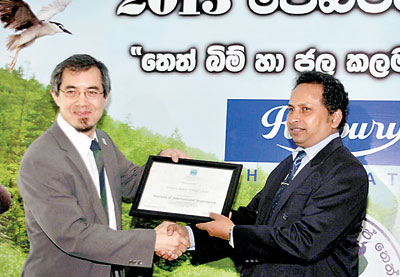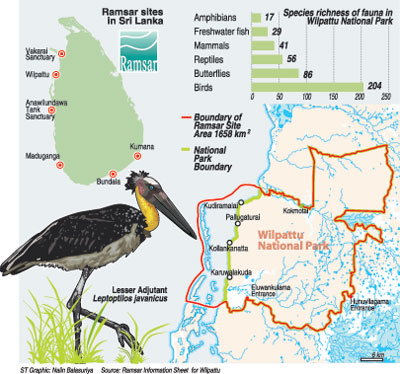News
Wilpattu certified as a wetland of world importance
View(s):The Wilpattu game reserve was recently named Sri Lanka’s sixth Ramsar Wetland, a name give to ecologically significant wetlands around the world. The Ramsar Convention, to which Sri Lanka is a signatory, is an international treaty for the conservation and sustainable use of wetlands. Bundala was Sri Lanka’s first Ramsar wetland, followed by Anawilundawa, Madu Ganga, Kumana and the Vankalai Sanctuary.

Dr. Lew Young handing over the Wilpattu Ramsar Certificate to H. D. Ratnayake
On February 2, World Wetland Day, Dr. Lew Young, senior advisor for the Ramsar Convention on Wetlands for Asia and Oceania, handed over the Wilpattu Ramsar Certificate to H. D. Ratnayake, director general of the Department of Wildlife Conservation (DWC).
During his visit, Dr. Young met officials responsible for protecting the country’s wetlands. He also gave a public lecture on the importance of wetlands and how they play a role in regulating the water we consume. This year’s Wetland Day theme, “Wetlands Take Care of Water”, is aligned with the United Nation’s Year of Water Cooperation.
Dr. Young said he and his colleagues were not aware that a road was being illegally constructed across the Wilpattu national park at the time the Wilpattu reserve was being considered for Ramsar endorsement. “But now that Wilpattu has been declared a wetland of international importance, it is all the more important that we protect Wilpattu,” Dr. Young said.
Wilpattu is on the northwest coast of Sri Lana and is the country’s largest and oldest national park. During the war, terrorists infiltrated the game reserve, killing the park warden. After the war, Wilpattu was again in the news when a controversial road linking Puttalam and Mannar and cutting across the national park was opened to the public. Environmentalists say the road is hazardous to wildlife and violates the Flora and Fauna Ordinance. Environmental Foundation Limited (EFL) has filed a case and the matter is before the Supreme Court.
“The Ramsar Convention promotes the sustainable use of wetlands, but balancing conservation and development is always a challenge,” Dr. Young said. Declaring Wilpattu a Ramsar wetland is only the first step. Wetland management involves setting up committees to monitor the well-being of Ramsar wetlands. These committees may include government agencies, adjacent communities and environment groups who are stakeholders of the sites.

Wilpattu has a total of 205 water bodies, natural and manmade, within its perimeter. Wilpattu is home to a unique habitat known as the “villu,” natural depressions in the land that will fill up with rainwater during the monsoon. The villus are havens of biodiversity. They attract waterfowl and other bird species, as well as wild animals, including elephants. Elephants in this part of Sri Lanka are said to be larger in size than the average Sri Lanka jumbo because they feed on nutrient-rich grasses growing in the villus.
The Wilpattu Ramsar site extends beyond the boundaries of the national park to the ocean front to include the rich coastal and marine habitats of Kalpitiya. Seagrass beds, mangroves, salt marshes, swamps and floodplain forests contribute to the area’s rich biodiversity. The park is home to 21 endemic vertebrate species, including the endangered Sri Lanka leopard (Panthera pardus ssp. Kotiya). The site once supported a thriving agricultural civilization, and 68 archaeologically important sites have been identified.
Other wildlife experts and conservationists present at the Ramsar ceremony were Dr. Channa Bambaradeniya; Manjula Amararathna of the Department of Wildlife Conservation; Udaya Sirivardana of the Ceylon Bird Club; Dr. Pradeep Nalaka Ranasinghe, Dr. Suranjan Fernando of the Centre for Applied Biodiversity Research, and Gamini Samarakoon.
Follow @timesonlinelk
comments powered by Disqus


















